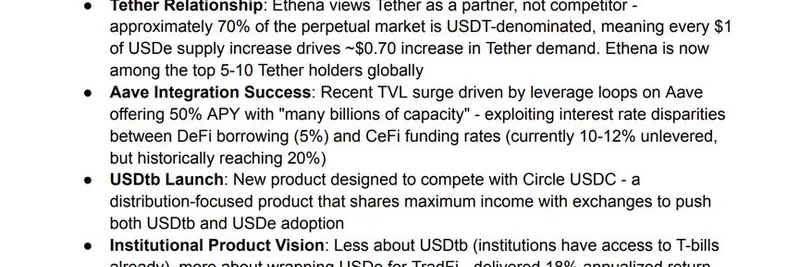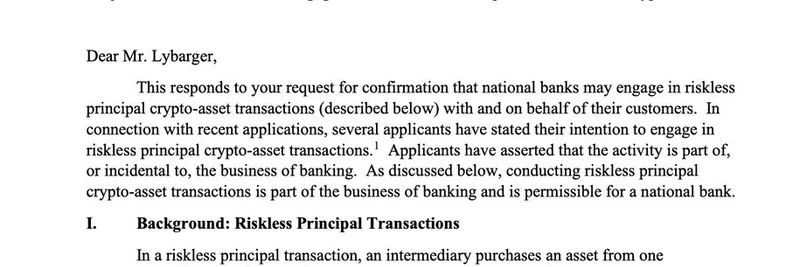If you've been following the crypto space, you know that stablecoins are more than just a safe haven—they're becoming powerhouses for generating yields. A recent X Spaces hosted by @goodalexander dove deep into "unlocking yields," featuring guests from Ethena (@gdog97_), Neutrl (@behrin_n), and USDAI (@0xZergs). Thanks to @0xf3dz for transcribing and summarizing it all in a thread that's packed with insights. Let's break it down in simple terms, especially if you're new to these concepts.
Ethena's USDe: Revolutionizing Synthetic Dollars
Ethena's USDe is a synthetic stablecoin that tokenizes the cash-carry basis trade—a strategy where you hold a spot asset and short its future to lock in yields. In just 18 months, it's grown to $12 billion, making it the fastest dollar-pegged asset to hit $10B.
The market opportunity here is huge: The crypto derivatives space has $120-150B in open interest, including CME, with annualized rates of 10-20%. This generates about $10B in gross cash flows yearly, right up there with giants like Binance equity and Tether.
One key innovation is custody. Post-FTX, Ethena set up zero collateral on centralized exchanges but uses sophisticated margin positions. This changes the risk profile while still earning credit for margins.
What sets Ethena apart is composability. While solo traders with $100-200M might get better returns, Ethena shines by tokenizing yields for broader use—like collateral in perps trading or DeFi integrations.
Ethena views Tether as a partner, not a rival. With every $1 in USDe supply driving $0.70 in increase for Tether demand, Ethena is now among the top 5-10 global Tether holders.
Their integration with Aave has been a hit, driven by leverage loops offering 50% APY on billions in capacity. This exploits rate disparities between DeFi borrowing (5%) and CeFi funding (10-12% unlevered, up to 20% historically).
Looking ahead, Ethena is launching USDTb to compete with Circle's USDC—a focused product sharing max income with exchanges. They're also eyeing institutional wraps of USDe for TradFi, delivering 18% annualized returns with zero volatility—better than most hedge funds.
On the tech side, they're building an L2 ecosystem on Celestia for institutional products. Plus, a fee switch timeline awaits a governance proposal for graduated take rate increases.
Ethena's philosophy? Grow to $30-50B in 2-3 years before heavy value extraction. As @gdog97_ put it, "I think Ethena now is definitely within the top 10, maybe within the top five Tether holders in the entire world." And on growth: "The supply chart in size of these businesses in five years time is basically just going to be Tether for that use case...and then Ethena number two."
Neutrl: Capturing Private Market Arbitrage
Neutrl, led by @behrin_n, focuses on buying top 100 market cap tokens at 20-70% discounts (typically 40-50%) from foundations and early VCs, then shorting perpetuals to lock in arbitrage.
Their revenue streams include funding rates on shorts, staking the underlying collateral, and management fees. Currently running $15M with only 20% in OTC arbitrage, 80% in liquid discretionary basis trades across ecosystems.
Sellers are often teams building businesses or early VCs recycling capital after big markups. Volume in private markets has been massive for 4 years.
Vesting is 12-48 months for periods, but they use yield-bearing stablecoins like USDe to buffer substantial buffers during rallies.
Reality check: Many hyped tokens from last year now trade 80-90% below OTC prices, validating their pessimistic approach.
Public launch in 1.5 months with transparency on collateral, exchange statements, and OTC token ownership.
Notable quote: "I'm happy when the funding rates are up because 80% of it is sitting in liquid stuff that we can move around and catch basis." And Alex called it "the ultimate black pill token"—you're long people selling their tokens at 40% discounts, then charts down only forever.
USDAI: Tokenizing AI Infrastructure Yields
USDAI from @0xZergs started from a simple idea: Couldn't get a loan against a single GPU server ($250-350K), so created a synthetic dollar yielding from AI infrastructure loans.
Market scale is enormous—Morgan Stanley projects $7 trillion in AI infra spend. A single Colossus xAI data center is like an airport or 3 Las Vegas spheres ($2.5B each); CoreWeave's $7.5B financing was Blackstone's largest ever at 15% APR.
Their MBS Model for GPUs: Creating mortgage-backed security equivalent for GPUs—a perpetual debt instrument enabling atomized loans, similar to Fannie Mae transforming real estate into $45T asset class.
They assume GPUs worth zero at year 3 (pessimistic), but H100s still trade 60-70% value after 3 years; uses 65% LTV with first-loss position.
Tax advantage: 100% bonus depreciation allows immediate tax deferral—"if you have any ordinary income above $250K, you should definitely buy a GPU this year."
Warehouse Receipt Innovation: Tokenizing GPUs using international trade standards—data centers as perfect escrow vehicles (military-grade security), trading receipts not the business.
Yield: 15-20% APR from loans, 13-18% steady state after haircuts, currently 7% as deploying capital.
Bitcoin mining parallel: Largest debt market in crypto isn't DeFi but Bitcoin mining—crypto natives understand hardware obsolescence.
Vision: Becoming "the interest rate protocol for AI"—enabling one-click: buy asset with debt, tokenize, borrow against it, rent it out, auto-repay.
Quotes: "There is literally not enough money in the world to scale this industry." "Not a single data center in the world is paid with cash. It's bought with debt." "CoreWeave is based in New Jersey, they're not in SF. They're just a finance company." "Solar doesn't make any sense in the US unless you have tax credits." "I view CoreWeave as just one big Aave/vena loop for TradFi and AI."
Key Nuggets and Future Research
From the discussion, success in stablecoins boils down to extremes: most liquid/safe (Tether) or highest yielding (Ethena); middle ground fails. Distribution via CEX partnerships is crucial.
Interest rates in crypto negatively correlate to real-world rates—when TradFi falls, crypto speculation rises, funding rates up.
The real unlock for institutions? Packaging crypto-native yields for TradFi consumption, not vice versa.
Portfolio approach can't concentrate in OTC bucket, needs diversification across liquid and illiquid positions.
Running Monte Carlo sims shows few tokens 5x anymore due to insufficient capital.
Separate capital from operator—nobody cares about FICO on Aave, only collateral.
Must find crypto-native yields to bring to TradFi, not reverse.
Equipment financing needs debt markets—no industry scales on equity alone.
Most valuable insights:
Interest Rate Arb: Disconnect between TradFi rates, DeFi overcollateralized borrowing (~5%), CeFi funding (10-20%) creates massive opportunities protocols like Ethena exploit at scale.
Tax-Advantaged GPU Financing: 100% bonus depreciation on GPUs creates immediate tax deferral opportunities—combined with 15-20% yields from USDAI loans, this creates a powerful investment structure previously unavailable to sub-$50M investors.
Stablecoin Success Formula: Win by being at the extremes - either the most liquid/safe (Tether) or highest yielding (Ethena); middle ground products fail. Distribution through CEX partnerships is critical.
Private Market Inefficiency: Top 100 tokens trading at 40-70% discounts OTC because large holders can't dump without destroying price - this creates systematic arbitrage opportunity that Neutrl is capturing.
AI Infrastructure Crisis: The $7 trillion AI buildout faces a fundamental financing gap - traditional lenders won't touch sub-$50M GPU loans, creating opportunity for crypto-native solutions to fill this massive void.
Worth further research: Ethena's upcoming "Stablecoin X DAT" with ticker TLGY on OTC (eventually USDE on Nasdaq), Celestia-powered L2 for institutions, Neutrl's public launch, Ambient testnet for proof-of-work AI mining, the "one big beautiful bill" for AI/crypto tax benefits, and how warehouse receipts/bailment structure legally works for GPU tokenization.
This thread highlights how stablecoins are evolving beyond memes into serious financial tools, bridging DeFi with TradFi. If you're into meme tokens, think about how these yield mechanisms could supercharge liquidity or create new plays. Stay tuned for more updates on meme-insider.com!




